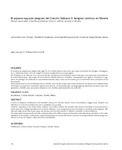Mostrar o rexistro simple do ítem
El espacio sagrado después del Concilio Vaticano II: templos católicos en Morelia
| dc.contributor.author | León Alvarado, Leticia Selene | |
| dc.date.accessioned | 2019-05-30T09:21:12Z | |
| dc.date.available | 2019-05-30T09:21:12Z | |
| dc.date.issued | 2005 | |
| dc.identifier.citation | León Alvarado, L. (2017). El espacio sagrado después del Concilio Vaticano II. Actas De Arquitectura Religiosa Contemporánea, 4, 102-107. https://doi.org/10.17979/aarc.2015.4.0.5125 | es_ES |
| dc.identifier.issn | 2340-5503 | |
| dc.identifier.uri | http://hdl.handle.net/2183/23078 | |
| dc.description.abstract | [Resumen] En el tema de arquitectura religiosa del siglo XX, el Concilio Vaticano II provocó una mayor producción de trabajos, investigaciones y reflexiones sobre cómo se adaptó el espacio arquitectónico a sus preceptos. Sin embargo, en lo referente a los casos de estudio, la balanza se ha inclinado hacia los templos que responden favorablemente a dichos preceptos, que surgen de una profunda reflexión teórica y simbólica, o proyectados por algunos arquitectos e ingenieros de prestigio. No obstante, en una realidad nacional, estos casos son los menos y el cumplimiento de los preceptos no tan favorecedor. Ante este panorama y en el entendido de los distintos tipos de personajes que toman decisiones de diseño en la materialización del templo, se propone la necesidad imperiosa de elaborar un documento que contenga algunas directrices de diseño que sean generales y flexibles para que pueda adaptarse a las distintas particularidades de cada sitio. | es_ES |
| dc.description.abstract | [Abstract] In terms of religious architecture in the twentieth century, the Second Vatican Council led towards a bigger work, research and reflections on how the architectural space adapted to its precepts. However, regarding to the study cases, balance has shifted towards the temples that respond favorably to those provisions, which arise from a deep theoretical and symbolic reflection, or are projected by some prestigious architects and engineers. Still, national reality shows that these cases are the less and the enforcement of Vatican’s precepts is not as flattering. Considering this background and in the understanding of the different types of characters who take design decisions in the materialization of the temple, it intends the urgent development of a document which containes some general and flexible design guidelines so they can adapt to each site and its peculiarities. | es_ES |
| dc.language.iso | spa | es_ES |
| dc.publisher | Universidade da Coruña | es_ES |
| dc.relation.uri | https://doi.org/10.17979/aarc.2015.4.0.5125 | es_ES |
| dc.rights | Atribución-NoComercial 4.0 España | es_ES |
| dc.rights.uri | http://creativecommons.org/licenses/by-nc/3.0/es/ | * |
| dc.subject | Arquitectura | es_ES |
| dc.subject | Concilio Vaticano II | es_ES |
| dc.subject | Templos | es_ES |
| dc.subject | Morelia | es_ES |
| dc.subject | México | es_ES |
| dc.subject | Architecture | es_ES |
| dc.subject | Second Vatican Council | es_ES |
| dc.subject | Temples | es_ES |
| dc.subject | Mexico | es_ES |
| dc.title | El espacio sagrado después del Concilio Vaticano II: templos católicos en Morelia | es_ES |
| dc.title.alternative | Sacred space after of the Second Vatican Council: catholic temples in Morelia | es_ES |
| dc.type | info:eu-repo/semantics/article | es_ES |
| dc.rights.access | info:eu-repo/semantics/openAccess | es_ES |
| UDC.journalTitle | Actas de Arquitectura Religiosa Contemporánea | es_ES |
| UDC.volume | 4 | es_ES |
| UDC.startPage | 102 | es_ES |
| UDC.endPage | 107 | es_ES |






